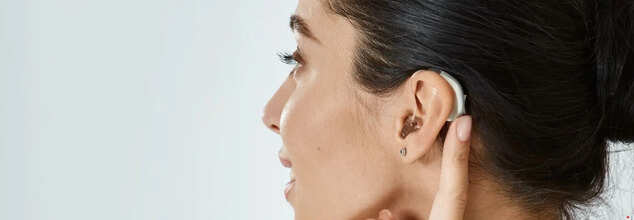- Health Conditions A-Z
- Health & Wellness
- Nutrition
- Fitness
- Health News
- Ayurveda
- Videos
- Medicine A-Z
- Parenting
- Web Stories
Women Have Sharper Hearing Skills Than Men, New Study Finds

Credit: Canva
Anyone who recalls whispering at the dinner table as a child likely also remembers being overheard and reprimanded by their sharp-eared mother, even as an oblivious father ploughed through his meal. Now, science has an explanation for this long-standing observation. A new study conducted by a team of British and French researchers tested around 450 people across 13 countries and found that women typically have higher hearing sensibility than men.
"Women consistently exhibit higher sensitivity by two decibels," the researchers wrote in a paper published in the journal Scientific Reports. This was true across the entire frequency spectrum tested and for all populations sampled. Surprisingly, the study found that in some groups, women's ears were up to six kilohertz sharper than men's. Women not only exhibit heightened cochlear sensitivity—referring to the fluid-filled part of the inner ear that converts sound waves into signals the brain can process—but also outperform men in other auditory tests.
"This difference stems from women's superior function in both the peripheral auditory system and the central auditory pathway. We were surprised to find that women had two decibels more sensitive hearing across all the populations we measured, and this accounted for most of the variations between individuals," said Turi King of the University of Bath in the UK.
People Living in Forests Can Hear Better
Beyond the gender-based differences, the study also uncovered that people living in forest environments exhibited the highest hearing sensitivity. In contrast, those residing in mountainous areas showed the lowest. The researchers noted that people living at higher altitudes tend to have reduced hearing capabilities.
Environmental factors like population density, natural soundscapes, and pollution levels were found to play a significant role in shaping auditory sensitivity. Language exposure also had a measurable impact.
Why Is This Study Important?
According to the lead researchers, the findings are significant because they challenge long-held assumptions about hearing. The study highlights the importance of considering both biological and environmental influences when examining auditory health.
Here's How You Can Enhance Your Hearing
- Avoid loud environments or use ear protection like earplugs or noise-canceling headphones.
- Keep earphone volume low—follow the 60/60 rule (no more than 60% volume for 60 minutes).
- Exercise regularly to improve blood circulation to the ears.
- Eat a balanced diet rich in omega-3 fatty acids and antioxidants.
- Stay hydrated to support overall ear health.
- Quit smoking and limit alcohol intake, as both can harm hearing.
- Manage stress, which can worsen tinnitus or hearing sensitivity.
- Clean your ears gently—avoid inserting cotton swabs or sharp objects.
- Go for regular hearing check-ups, especially if you notice any hearing changes.
- Seek early treatment if you experience ringing, pain, or hearing loss.
Jesse Eisenberg Opens Up About Donating His Kidney to a Stranger; Understanding The Risks And Health Implications

(Credit-Golden Globes)
Jesse Eisenberg has opened up about his intention to donate his kidney to a stranger. He deemed the decision as a “no-brainer.” Known for films like Now You See Me, the 42-year-old actor shared the news on the Today show on October 30th, as he explained that he got the "blood donation bug" after participating in a blood drive over the summer.
Eisenberg stated he is scheduled for an altruistic donation, which is also known as a non-directed living donation, in mid-December. This means he is donating his organ to someone he does not know, with the recipient being selected based on medical compatibility.
Eisenberg stands by his decision, emphasizing, “It's essentially risk-free and so needed." He believes more people will realize "it's a no-brainer, if you have the time and the inclination.”
His reason for saying that donating his kidney is a ‘risk free’ decision is that, after this procedure, through the National Kidney Foundation's family voucher program, his family would be prioritized should if any of them ever need a living kidney donation in the future.
Donating a kidney can help improve the quality of life and survival for the receiver, however there are a few health implications one should keep in mind.
What Happens When You Do A Living Kidney Donation?
The American Kidney Fund explains that a living donation is a kidney transplant where a person who is alive and healthy gives one of their two healthy kidneys to a person with serious kidney disease. Kidneys that come from a living person usually work better and last longer than those that come from someone who has died. There are 2 types of kidney donations:
Non-directed Donation (Altruistic Donation)
This is when the person donating the kidney does not pick the recipient. Instead, they donate the kidney to a stranger. This is often done through a program that helps swap kidneys between people (a paired kidney exchange). Jesse Eisenberg is opting for this method.
Directed Donation
This is when the person donating the kidney chooses the specific person who will receive it, for example, a family member or a close friend.
Who Can Donate A Kidney, Are There Any Benefits?
To be able to donate a kidney while you are alive, you must meet a few requirements:
- You must be 18 years old or older.
- You must have two healthy, working kidneys.
- You must be healthy enough to handle the surgery and recovery.
Most people who donate a kidney can get back to their normal life in about two to four weeks. However, a team of doctors and nurses carefully checks the donor to make sure they understand all the possible physical, emotional, and financial risks.
- You help the person who receives your kidney to live longer and be healthier, and you may even save their life.
- The detailed check-up you go through helps you learn more about your own health.
What Are The Health Risks of Kidney Donation?
Like any surgery, kidney donation also carries physical risks. These can include common issues like pain at the surgical site, feeling weak and tired, or bloating. More serious, though less frequent, risks involve bleeding and the formation of blood clots, problems related to anesthesia such as pneumonia, a blocked bowel, and the possibility of infection. Additionally, donors will have a scar from the surgery and may feel sick to their stomach afterward.
The American Kidney Fund also explains that there may also be some emotional risks involved. Some people feel anxious, stressed, sad (depressed), or guilty if the kidney they gave doesn't work well for the recipient. It is a very noble task to help someone gain a second chance for a better life. Understanding the risks and health implications can help you make the most informed choice. Let your healthcare professionals know about your doubts and worries, as it will help them make the process better for you.
Donald Trump Mistakes Cognitive Exam For IQ Test; Experts Say His Confusion May Be A Sign Of Dementia

Credits: Canva
US President Donald Trump recently claimed he had taken an “IQ test,” seemingly mistaking it for a dementia screening exam. Boasting that he achieved a perfect score, he also challenged Democratic representatives Jasmine Crockett and Alexandria Ocasio-Cortez (AOC) to attempt the same test.
Speaking aboard Air Force One, the 79-year-old described the exam as “very hard,” while mocking his opponents as “low IQ” individuals. This mix-up has once again drawn scrutiny to his cognitive health, with experts suggesting the confusion could be a possible sign of dementia.
Donald Trump Mistakes Cognitive Exam For IQ Test
On Monday (October 27), Trump told reporters that he had aced an intelligence test at Walter Reed Army Medical Center in Washington D.C. According to The New Republic, the test he referred to is likely the Montreal Cognitive Assessment (MoCA), a short 10-minute screening tool designed to detect early signs of dementia or Alzheimer’s disease. Despite this, Trump appeared to treat it as an intelligence measure rather than a diagnostic tool.
During his remarks, the Republican challenged Crockett, 44, and Ocasio-Cortez, 36, to take what he called the “IQ test.” “Let Jasmine go against Trump,” he said. “The first couple of questions are easy: a tiger, an elephant, a giraffe, you know. But when you get up to about five or six, and then 10, 20, 25—they couldn’t answer any of them,” he added.
Donald Trump’s Verbal Gaffes
This is not the first time Donald Trump has spoken about the MoCA test in exaggerated terms or made verbal missteps. Back in 2020, he told Fox News that he was asked “30 to 35 questions” of varying difficulty. “They always show you the first one, like a giraffe, a tiger, or a whale—‘Which one is the whale?’ OK. And then it gets harder and harder,” he said at the time, insisting that others had struggled where he had not.
Observers have long noted that Trump’s speeches often include rambling detours and non-sequiturs. “His speeches are full of non sequiturs,” said historian Kristin Kobes Du Mez of Calvin College, who has compared the speaking styles of Trump and Hillary Clinton. “It’s a completely different style from nearly any other politician you normally see on a big stage.”
Is Donald Trump Showing Early Signs of Dementia?
Clinical psychologists Dr. Harry Segal and Dr. John Gartner have expressed concern about the president’s psychomotor performance, suggesting that he may be displaying early indicators of dementia. Speaking in a recent episode of their program Shrinking Trump, Dr. Gartner said, “We’ve been observing a clear decline in his motor performance, which aligns with dementia, as it typically involves deterioration across all faculties and functions.”
He added that Trump’s public demeanor, language, and verbal disorganization have become more apparent signs of cognitive changes. According to The Mirror, Trump has also been seen attempting to conceal his hands in public, prompting further speculation about his health.
The recent mix-up between the Montreal Cognitive Assessment and an IQ test, some experts say, could further reinforce these concerns. To better understand this, we spoke with Dr. Neetu Tiwari, MBBS, MD (Psychiatry), Senior Resident at NIIMS Medical College & Hospital.
She explained, “Confusing the nature of the test could be something worth noting. In itself, a single instance of confusion does not amount to a diagnosis of Frontotemporal Dementia (FTD) or any other dementia type. But if this kind of misunderstanding is part of a wider pattern—repeated confusion, new behavioural changes, personality shifts, language difficulties, or problems managing daily tasks—it would justify a full cognitive and neurological assessment. Early detection often relies on observing clusters of symptoms that persist or worsen over time.”
Summing up her view, Dr. Tiwari added that while it is possible for such mislabelling to be a small indicator, it is not strong evidence on its own. “Context matters,” she said. “Age, baseline cognitive ability, education, emotional state, stress, and fatigue all influence mental performance. The responsible next step is to monitor whether other changes are taking place, and if so, to seek a detailed evaluation from a neurologist or neuropsychologist.”
Morning-After Pill To Be Offered Free At 10,000 Pharmacies Across England: What You Should Know

Credits: Canva
The NHS has made the morning-after pill available for free in pharmacies across England, aiming to eliminate the “postcode lottery” that limited access to emergency contraception. Nearly 10,000 pharmacies can now provide the pill without charge, meaning women no longer need to visit a GP or book an appointment at a sexual health clinic to access it. Previously, some pharmacies charged up to £30 for the emergency pill.
Free Emergency Contraception Now Available at Pharmacies
Thousands of women in England can now access the morning-after pill for free from local pharmacies under the government’s NHS reforms, which are designed to make healthcare services more accessible without requiring GP appointments.
Research suggests that one in five women aged 18 to 35 will need emergency contraception each year. The pill can be taken up to five days after unprotected sex to prevent pregnancy.
Before this change, women had to buy the pill over the counter for as much as £30 or seek it free from GPs and sexual health clinics. However, both options often came with barriers such as appointment delays or reduced clinic availability due to funding cuts. With the pill being most effective when taken soon after unprotected sex, the NHS move has been welcomed by health advocates as a timely and practical step.
Where Can You Get the Free Morning-After Pill?
As reported by The Independent, around 10,000 pharmacies in England, including major chains like Boots and Superdrug, as well as independent outlets, are now offering the morning-after pill free of charge.
Claire Nevinson, Superintendent Pharmacist at Boots, said that pharmacists can also provide confidential advice on contraception choices. “Expanding the NHS Pharmacy Contraception Service to include access to emergency hormonal contraception is a significant step forward in helping women get timely healthcare,” she explained.
“Women can visit their local Boots pharmacy for free contraception advice, support, and medication—without needing a GP or clinic appointment.”
What Was the Situation Before This Change?
Until this rollout, women often had to make an appointment at a clinic or contact their GP to obtain emergency contraception, which sometimes led to delays, especially over weekends or in rural areas. Under the new plan, women of reproductive age can now walk into any participating pharmacy and speak directly with a trained pharmacist. Consultations are private, and the pill is dispensed immediately if appropriate.
This initiative adds to a growing list of NHS pharmacy services, which now include starting or continuing regular birth control, getting advice after beginning antidepressants, and receiving blood pressure checks and vaccinations. The goal is to make local pharmacies a convenient first stop for everyday healthcare needs.
A Step Toward Easier Access
The new scheme represents a broader effort to expand women’s healthcare access across the country. By making emergency contraception free and widely available, the NHS hopes to remove financial and logistical barriers that previously prevented timely use.
Disclaimer: This article is for informational purposes only and is not a substitute for professional medical advice or diagnosis. Always seek the guidance of your doctor or another qualified healthcare professional regarding any medical questions or concerns.
© 2024 Bennett, Coleman & Company Limited

